Fish Files: Blue Tang
Overview
Blue Tang (Paracanthurus hepatus) or commonly known by other names as Regal Blue Tang, Royal Blue Tang, Pacific Blue Tang or Palette Surgeonfish and so on, are commonly found in the reefs across the Indo-Pacific. These Tangs boast an electric blue body with bold black markings starting from their eyes, down their dorsal and through their tail.
Although strikingly beautiful and being a peaceful species that suits almost any large community marine aquarium, their dorsal contains a toxin that can cause severe pain to small predators as well as humans, so take caution when handling.
Blue Tangs are ideally suited to a large tank with plenty of living rock for them to hide amongst and eat the algae from that may well cover the coral. They require a higher level of care, so may be more suited to an experienced marine (saltwater) aquarist.
Fish Keeping Information
|
Classification |
Paracanthurus hepatus |
|
Care Level |
Intermediate/advanced |
|
Fish Size |
This species can grow up to a foot |
|
Water Temperature |
23-27 deg C (73-81 deg F) |
|
pH |
8.1-8.4 |
|
Aquarium |
Young tang minimum 300 litres |
|
Gender Differences |
Difficult to determine the differences between males and females. |
|
Feed |
Algae/seaweed is their main diet. However a mix of mysis, brine, copepods krill and fish/lobster eggs. Dried foods can be offered and will be accepted in time. |
|
Compatibility |
Should be kept with other peaceful community fish that won’t compete for food. |
Characteristics
Blue Tangs are clearly identified in any saltwater aquarium by their bright blue colouring, flat oval bodies and bold black markings. As juveniles in your tank, the Tang may start anywhere from around half an inch and as an adult can grow to be a foot long (roughly 30cm).
A young tang can go in a tank of around 300 litres+ but be aware you will need to upgrade your tank as they get bigger to a minimum of 700 litres; however, it takes many years for them to get to their full size.
Behaviour
Blue Tangs are commonly a peaceful species towards most tank mates. They may become aggressive towards other fish of its own species, and therefore we suggest keeping one per tank. The ideal tank mates should be of a similar peaceful nature and not direct competitors for food, otherwise fish with a boisterous nature may prevent them from feeding.
Paracanthurus hepatus fish are an active species that likes to hide among live rock, as well as swimming, you’ll often find them darting around the tank, meaning they require a lot of space in an aquarium.
Although their dorsal does contain a toxin, when faced with a predator, blue tang’s may "play dead" by laying on their side and remaining motionless until the predator passes them by.
Breeding
Blue Tangs are not likely to breed in a home aquarium; there have currently been no success in breeding in captivity. In the wild, these fish spawn on a seasonal basis, with several thousand eggs released into the water above the coral.
